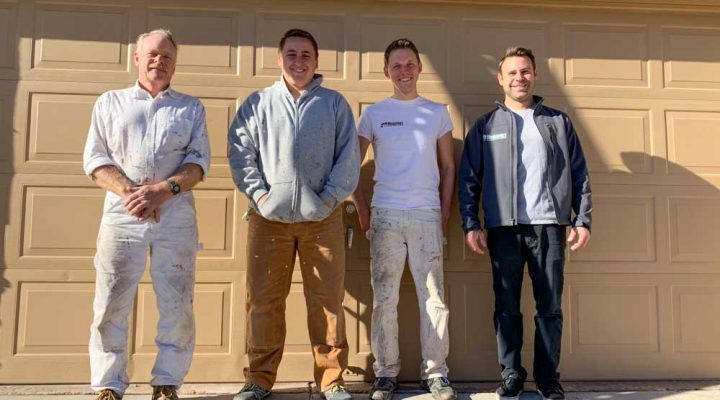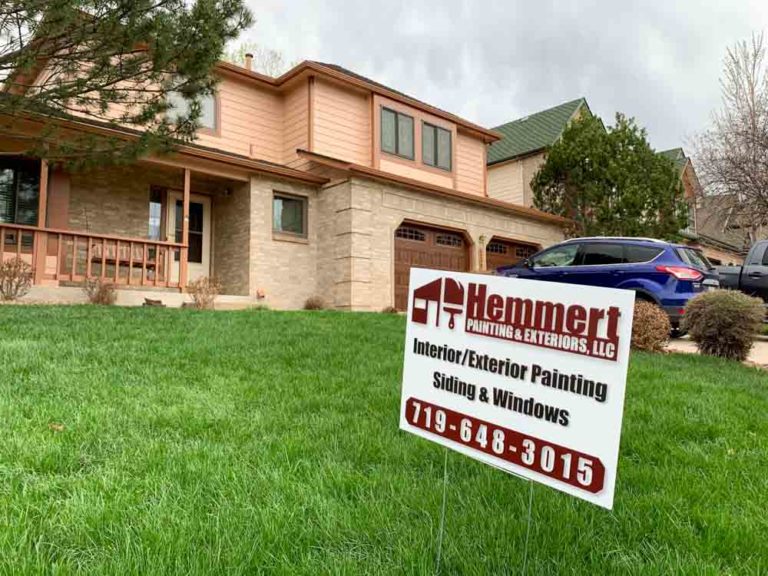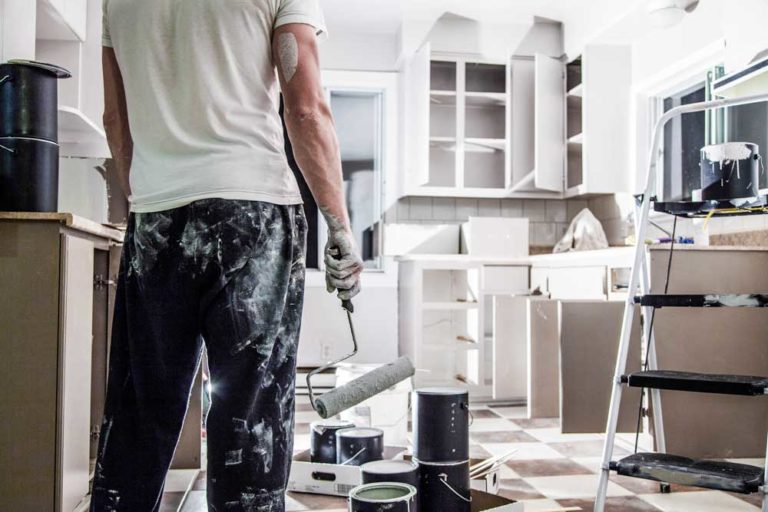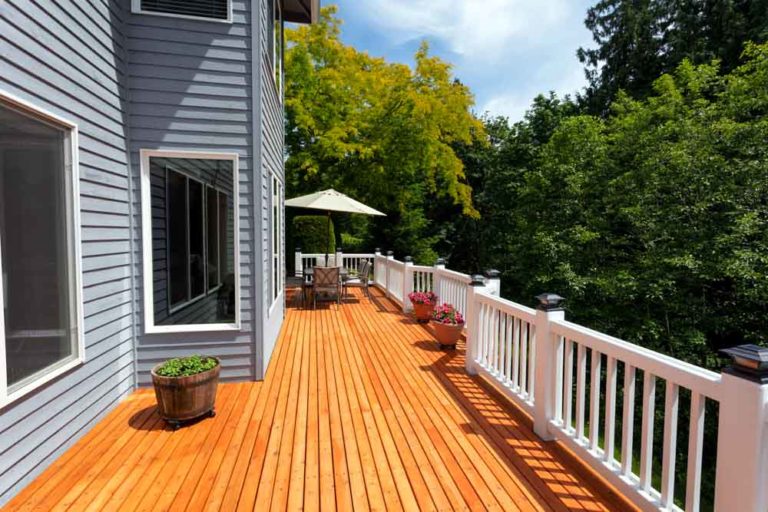New STABLE GENIUS Act Would Mandate Mental Fitness Exams for Presidential Candidates dianabol 10 Leg Exercises To Run Faster | Fitness Republic
As the saying goes, with privilege comes responsibility. And being a homeowner is a great privilege indeed. So as a diligent and responsible homeowner likely you have come here because you want to know what maintenance schedule to follow and when you should consider painting the outside of your house. While the most correct answer will always be ‘it depends’, a good general rule of thumb to follow is that a paint job will typically last somewhere between 5 to 10 years for a typical wood-sided home. Then you can either subtract from or add to that number depending on a couple of key factors. The first being the actual construction type of your home, or in other words what building materials were used to side your home. And the second being the quality of not just materials but also the labor that went into previous paint jobs.
If you are based in Colorado Springs and you are planning to paint your home exterior, send us a message and tell us more about your project!
Let’s go ahead and break this down further based on the specific construction type of your home.
GENUINE WOOD SIDING
I have met with quite a few customers over the years who own homes built sometime around the turn of the century up to sometime in the ’60s let’s say (although there is always some overlap here in construction styles). And these homeowners typically have the same concerns. They ask me to inspect the house carefully for signs of wood rot, foundation issues, or even bigger problems. Usually, the owner is concerned that the lack of governance and home building standards of yesteryear might mean their home is of lower quality and is likely to experience more maintenance problems. I haven’t really found this to be the case. At least when it comes to those surfaces preserved by paint.
In fact, I believe the quality of building materials has gotten progressively worse over the years. So these old homes built with full wood materials are surprisingly rot-resistant and continue to hold paint very well, or at least better than a modern home for the most part. To illustrate, many of these old homes constructed over a century ago have been painted over many times but they still wear their original wood siding skin on the outside. How many homes built within the last 50 years will be able to say this by the time they hit their 100th birthday?
An old victorian. Keep a close eye on these windows for early signs of rot.
If you are privileged to live in one of these old Victorian or Craftsman works of art, you simply want to keep an eye on the more critical areas and watch for the first signs of paint failure. Take these indicators very seriously! Here I’m referring to the building components that are not easily replaceable. Often times a homeowner will tell me over the phone that they have some trim boards that need to be changed out before we paint. However, these ‘trim boards’ often turn out not to be trim boards at all but rather an integral part of a window or door. If these rot out you may be forced to replace them with a modern equivalent which may be more energy efficient but will certainly downgrade the style of your home and will likely cost you a small fortune that you hadn’t budgeted for.
It’s not uncommon for me to run into an owner of one of these older homes that cannot tell me when their home was last painted. It could have been 20, 30, or more years ago. While I don’t recommend you neglect your home for this long, oftentimes the wood is in okay condition as long as the occasional paint touchup has been done. I recommend keeping a good handyman on speed dial for this sort of thing. Have him or her come out once a year and spend a half-day scraping, sanding, priming, caulking, and touching up any raw wood. If you are willing to keep up with this annual maintenance, an old wood-sided home paint job can easily last 10 to 15 years.
ASBESTOS SIDING
I have heard a lot of negative publicity about asbestos siding over the years. Just the word itself evokes dreadful images in a lot of people’s imaginations. And the health hazards associated with asbestos siding are widely publicized elsewhere so I won’t go into that here. Everyone has to make a very personal decision about what is safe for their family. But in my experience, if left undisturbed, asbestos siding is a very high-quality protective siding material that has held up incredibly well over the years.
Nothing at all wrong with the 10-year-old paint on this asbestos siding
Very rarely will you NEED to paint asbestos siding for protection? Since this siding is no longer being made, you will always have asbestos siding with a previous coating of paint on it. And if the coating is in good shape you are good to go. It’s more likely you will want to paint it because the old paint has faded so badly that it no longer looks good, or you are just tired of the color.
More commonly, you will repaint asbestos siding when the surrounding wood trim starts to peel or show signs of deterioration. Much like the wood-sided home described above, routinely touch up failing paint when you see it on wood surfaces and you could probably push a full repaint job out 20, 30, or more years if you want to. No real damage will occur to the siding itself due to a lack of paint maintenance. Since painted asbestos siding is almost completely non-porous, it takes very little paint to properly coat it, which makes a paint job fairly affordable when compared to other home construction types.
WOOD COMPOSITE SIDING
This is by far the most common type of siding around this part of the country (Colorado) for all homes built in the last 40 years or so. Sadly, in my opinion, the terms wood-sided home and composite wood siding are typically used interchangeably. And this wood composite material is far inferior to actual wood. But since it is such an affordable option, it has become very popular with builders over the years. The product can also be called engineered siding, hardboard siding, hardwood siding, or casually called ‘masonite siding’ which is actually one of the original brands that first manufactured a product of this type. It is now sold under many different brand names.
My best recommendation is to stay ahead of the maintenance as best as you can. Once it loses its protective paint coating, the wood-based product tends to aggressively soak up moisture like a wick on an old-fashioned oil or kerosene lamp. And once it starts you can’t really undo the damage that has been done. Often you won’t notice the damage until it’s too late. The problem is that, while the siding will typically dry out quickly after the storms pass, it will never return to its normal shape and density again. The bottom edge of the siding will start to swell up as the adhesives loosen. It will feel soft and spongy to the touch in advanced stages of deterioration and, at this point, it’s so soft and flexible it just won’t hold paint or primer for very long no matter what you do.
It’s not too late to save this siding, however, these underneath edges and raw wood around the nail head must be hand sanded down to raw wood, primed by brush, and thoroughly top coated to avoid future swelling.
Regretfully I have had to turn down a few paint jobs over the years for moral reasons. Not only could I not guarantee my work, but I could almost guarantee my paint job would start to fail within the year. If you think you are at this point already, contact a painting contractor and ask him about his warranty. He or she should be honest with you about the condition of the siding. It can be tempting to accept the lowest-priced bid in this case. Especially if you have already resigned yourself to the fact that the siding is slowly deteriorating and will need to be replaced someday. However, cheaping out on a paint job can dramatically accelerate the time until you need to replace the siding, and can also make each successive paint job more expensive to perform correctly.
Spraying a light coat of primer or topcoat paint on these troublesome underneath edges of siding is simply not an acceptable solution. You just can’t get enough paint on that tiny edge with that type of application technique, and you will never get the amount of penetration you need to properly seal up this porous surface. A quality painter will be happy to discuss with you the importance of sanding any loose paint from the previous paint job and then either brushing or rolling primer on all these underneath edges to guarantee you the maximum life out of your paint job. This is the procedure that must be used if you are aiming for a 7 to 10-year lifespan out of your paint job. However, if this procedure has not been followed in the past it may be impossible to undo the damage that has already been done. And at some point, it becomes better to just bite the bullet and say no more painting. Just save your money until you are able to tackle a re-siding job.
HIGH-QUALITY WOOD COMPOSITE SIDING
Some manufacturers have more recently come out with a similar wood composite product which may prove to be an upgrade in the long run. This newer product is basically an Oriented Strand Board (OSB) based siding at its core with a textured pattern stamped into the face of it. It looks nearly identical to the old style pressed board and can be a great solution when it comes time to replace individual sheets of siding on your home that need to blend unnoticeably with the other older style pressed board siding. But let’s not forget that OSB is still just glued-together wood fibers.
The traditional pressed board siding is still being sold today, but often this upgraded OSB version is sold right beside it at the local lumberyard for just a few dollars more per sheet. Only time will tell if this product holds up better than its older sibling. If you know that you have this product on your entire home, I would still plan for a typical paint cycle of once every 10 years. It’s likely you will see most of the caulk joints cracking out at this point and will have peeling paint in places.
FIBER CEMENT BOARD
If you live in a fairly modern home you just may find yourself lucky enough to have this exterior siding material. Many fiber cement products come pre-finished. Any time you can select a pre-finished product always go that route, assuming they offer a color you like. This applies to everything from gutters to overhead garage doors and entry doors. Typically, with a pre-finished product, the product itself is heated up to high temperatures in a climate-controlled factory where the coating is then applied by a machine. This procedure “bakes” on the paint, therefore creating a better bond between paint and substrate and leaving a finish free of any inconsistencies or imperfections. This result will almost always be superior to a field-applied finish where wind, humidity, and sunshine all threaten to sabotage your perfect paint job before it has time to fully cure.
Nevertheless, this doesn’t mean your fiber cement siding will never need to be painted. Some products come from the manufacturer with only a primer coat applied and are ready to accept a protective topcoat paint when new. And eventually, even the pre-finished material will start to show signs of UV damage as the color loses its luster and sheen. However, with fiber cement, the repaint cycle is greatly extended when compared to most other sidings. The maintenance cycle is much more similar to that of asbestos siding, without the threat to your health.
If it weren’t for the fact that hail got to it early, this coating on fiber cement would be good for many more years to come.
You should expect that a fiber cement paint job will last 12 years or more due to the fact that the product is non-porous and it is easier to create a smooth and uniform barrier with paint that will continue to hold back both sun and moisture. And because the material resists absorbing water like some of the previously-mentioned products, it is very uncommon to see moisture-related paint failure such as peeling or bubbling of the paint. Even if you exceed the life of your paint job, the risk of having to replace siding is minimal.
VINYL SIDING
Vinyl siding first gained popularity when companies like sears started pushing the product through door-to-door sales. They would market the product as a maintenance-free and cost-effective solution to the constant paint maintenance and upkeep of the older style wood home. It gained a lot of traction and is still in use today. Even now some builders put vinyl siding on brand new homes. I’m not, particularly a fan of this type of siding. I see it as more of a temporary, disposable solution since it really cannot be maintained very well. It will eventually warp, become brittle, and in extreme cases crack and come loose from the home.
Warpage due to application of non-vinyl-approved paint
If you like your vinyl siding and want to preserve it as long as possible, it can usually be painted. But proceed with caution since it is possible to do more harm than good and accelerate the rate of aging of your siding. You will want to check with the product manufacturer since, oftentimes, painting the siding will void the warranty. Also double-check with the paint manufacturer as well to confirm that the product is vinyl safe. Some manufacturers like Benjamin Moore will offer a more limited palette of vinyl safe colors. In my experience, painting with dark color can attract the sun leading to UV damage and warping of the siding. At that point, you will quickly find yourself looking at a full siding replacement.
STUCCO
Stucco has traditionally been thought of as a maintenance-free coating. This is simply not true. While it is true that stucco will last a very long time, you can see from inspecting any old stucco building that it will eventually crack and can break away in chunks if not cared for. For the most part, a coat of paint will do very little to prevent the stucco from breaking and falling off of the home if damage has already occurred or if the original stucco job never really bonded to the wire underneath. However, you do want to take proper measures to prevent any future damage from the elements.
I recommend you start by making sure that you have proper drainage around your home; both down low at ground level and up high along the roofline. Since stucco is a semi-permeable material (it is not waterproof despite popular opinion), it is very important that water not pool up and sit on stucco surfaces for long periods of time.
With a stucco finish, it is usually very easy to see if you have drainage problems. You will start to see efflorescence forming on the surface which appears as a white chalky powder. This can be caused by anything from a leaky gutter to an improperly aimed sprinkler. But regardless of its cause, signs of this buildup on the stucco surface are bad news for the lifespan of your home exterior.
Often the best maintenance for a stucco home is not to paint at all, but rather to pressure wash off any efflorescence or other mineral deposits that detract from the appearance of your home. However, if you are frustrated by the number of stress cracks that have formed over the years, an elastomeric paint is the product recommended to take care of this eyesore. This product is best described as a very thick paint designed to bridge these small hairline cracks that form over time. Elastomeric paints are sold at many different price points, and generally, the more you pay for an elastomeric product the thicker it will be and the better its bridging properties will be. It would be a waste of time and money to apply an inferior elastomeric coating only to find you could still see where all the cracks are because the coating simply soaked into them.
Stress cracks in 15-year-old stucco
Keep in mind, once you paint your home you have introduced an element of maintenance that was not there before. Now you have not just an exterior stucco surface but also a painted-on coating that must be cared for. It will eventually fade like any other paint and could even peel in places if moisture works its way behind the paint layer. Make sure to do your homework to determine if an elastomeric coating is right for you before taking the plunge.
Stucco painted with an elastomeric coating
We all try hard to be good stewards of our homes so that we can get the most enjoyment out of them as possible and for as many years as possible. And at the same time most of us would also like to feel proud to pass them on to someone else someday who might get as much enjoyment out of them as we have, knowing that we have done our part to hopefully preserve the home for generations to come.
This has been a rather verbose analysis of the paint cycles unique to a variety of different exterior siding surfaces. Hopefully, you found what you need somewhere in here. But if you have any additional questions feel free to reach out to us via our Contact page. Happy painting!














